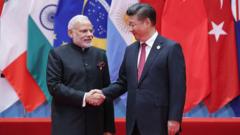
India-China Relations: A Thawing Ice, But Significant Challenges Persist
The complex relationship between India and China, two of the world's most populous nations and burgeoning economies, has been under intense scrutiny in recent years. While there have been discernible improvements in bilateral relations since the tense border clash of 2020, significant underlying challenges continue to shape the trajectory of their interactions.
Recent Positive Developments
Following a period of heightened tension and military build-up along the Line of Actual Control (LAC), both India and China have engaged in multiple rounds of diplomatic and military talks. These discussions have yielded some positive outcomes, including:
- Disengagement in Some Areas: Troops have disengaged from several key friction points along the LAC, contributing to a de-escalation of immediate tensions.
- Continued Dialogue: Despite disagreements, both sides have maintained open channels of communication, demonstrating a commitment to resolving disputes through peaceful means.
- Economic Ties Remain Strong: Despite geopolitical challenges, trade between India and China has continued to grow, highlighting the economic interdependence between the two nations.
Underlying Challenges: A Deeper Dive
Despite these positive developments, a number of significant challenges continue to cast a shadow over India-China relations. These challenges are multifaceted and require sustained efforts to address effectively.
Border Disputes
The unresolved border dispute remains the primary source of tension. Differing interpretations of the LAC and competing territorial claims continue to fuel distrust and the potential for future clashes. Key areas of contention include:
- Aksai Chin: India claims Aksai Chin, currently administered by China, as part of its territory.
- Arunachal Pradesh: China claims the Indian state of Arunachal Pradesh as part of South Tibet.
- Demchok and Depsang Plains: These areas have witnessed significant military build-up and standoffs in recent years.
Strategic Competition
Beyond the border dispute, India and China are engaged in strategic competition across various domains, including:
- Regional Influence: Both nations are vying for influence in South Asia and the wider Indo-Pacific region. China's Belt and Road Initiative (BRI) has raised concerns in India about its strategic implications.
- Naval Presence: The increasing naval presence of both countries in the Indian Ocean has intensified strategic competition and concerns about maritime security.
- Technological Leadership: Both India and China are investing heavily in emerging technologies such as artificial intelligence, 5G, and semiconductors, further fueling strategic competition.
Economic Imbalance
The economic relationship between India and China is characterized by a significant trade imbalance, with India running a substantial trade deficit. This imbalance is a source of concern for India, as it raises questions about the sustainability of the economic relationship. Key issues include:
- Limited Market Access: Indian businesses face challenges in accessing the Chinese market, while Chinese products have relatively easy access to the Indian market.
- Non-Tariff Barriers: India has raised concerns about non-tariff barriers imposed by China, which hinder the export of Indian goods.
- Dependence on Chinese Imports: India's dependence on Chinese imports for critical raw materials and components poses a vulnerability.
Geopolitical Alignments
India's growing strategic alignment with the United States and other Quad members (Australia and Japan) has been viewed with suspicion by China. China perceives the Quad as an attempt to contain its rise and counter its influence in the Indo-Pacific region. Conversely, India views its partnerships as a means of safeguarding its interests and promoting a rules-based international order.
Looking Ahead: Navigating the Complexities
The future of India-China relations will depend on how effectively both nations manage the challenges outlined above. Key areas for focus include:
- Strengthening Dialogue Mechanisms: Continued engagement through diplomatic and military channels is crucial for resolving disputes and building trust.
- Enhancing Transparency: Greater transparency on military deployments and activities along the LAC is essential for preventing misunderstandings and escalations.
- Promoting Economic Cooperation: Efforts to address the trade imbalance and promote greater market access for Indian businesses in China are necessary for fostering a more sustainable economic relationship.
- Managing Strategic Competition: Both nations need to find ways to manage their strategic competition constructively and avoid actions that could undermine regional stability.
India and China's relationship is undoubtedly one of the most consequential bilateral relationships in the 21st century. While recent improvements offer a glimmer of hope, the path ahead remains fraught with challenges. Successfully navigating these complexities will require sustained efforts, mutual understanding, and a commitment to peaceful resolution of disputes.
